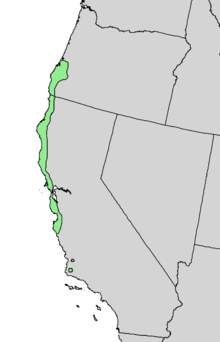
Syringa is a genus of 12 currently recognized species of flowering woody plants in the olive family or Oleaceae called lilacs. These lilacs are native to woodland and scrub from southeastern Europe to eastern Asia, and widely and commonly cultivated in temperate areas elsewhere.

Ceanothus is a genus of about 50–60 species of nitrogen-fixing shrubs and small trees in the buckthorn family (Rhamnaceae). Common names for members of this genus are buckbrush, California lilac, soap bush, or just ceanothus. "Ceanothus" comes from Ancient Greek: κεάνωθος (keanōthos), which was applied by Theophrastus to an Old World plant believed to be Cirsium arvense.

Syringa vulgaris, the lilac or common lilac, is a species of flowering plant in the olive family Oleaceae, native to the Balkan Peninsula, where it grows on rocky hills. Grown in spring for its scented flowers, this large shrub or small tree is widely cultivated and has been naturalized in parts of Europe, Asia and North America. It is not regarded as an aggressive species. It is found in the wild in widely scattered sites, usually in the vicinity of past or present human habitations.

Erica vagans, the Cornish heath or wandering heath, is a species of flowering plant in the family Ericaceae, native to Ireland, Cornwall, western France and Spain. It is a vigorous, spreading, evergreen heather reaching 75 cm (30 in) tall and wide, with pink flowers borne in racemes 14 cm (6 in) long in summer and autumn. The Latin specific epithet vagans literally means "wandering"; in this context it means "widely distributed".

Viburnum tinus, the laurustinus, laurustine or laurestine, is a species of flowering plant in the family Adoxaceae, native to the Mediterranean area of Europe and North Africa. Laurus signifies the leaves' similarities to bay laurel.

Vinca major, with the common names bigleaf periwinkle, large periwinkle, greater periwinkle and blue periwinkle, is a species of flowering plant in the family Apocynaceae, native to the western Mediterranean. Growing to 25 cm (10 in) tall and spreading indefinitely, it is an evergreen perennial, frequently used in cultivation as groundcover.

Ligustrum ovalifolium, also known as Korean privet, California privet, garden privet, and oval-leaved privet, is a species of flowering plant in the olive family Oleaceae. The species is native to Japan and Korea.

Ceanothus arboreus is a species of perennial shrub to small tree in the family Rhamnaceae, commonly known as the feltleaf ceanothus, island ceanothus, and island mountain lilac. It is the largest member of the California lilacs, and is characterized with glossy, dark green foliage that is adorned by pale blue to white flowers in bloom. It is endemic to the Channel Islands of California and Guadalupe Island in Mexico, only being re-discovered on Guadalupe Island after the elimination of feral goats.
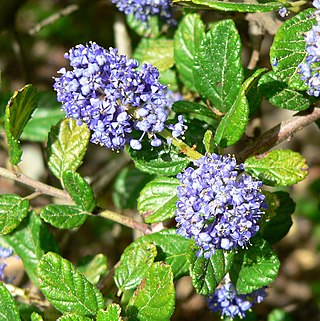
Ceanothus griseus is a species of flowering shrub known by the common names Carmel ceanothus and Carmel creeper. 'Carmel' refers to the Carmel-by-the-Sea region in California.

Callicarpa bodinieri, or Bodinier's beautyberry, is a species of flowering plant in the genus Callicarpa of the family Lamiaceae, native to West and Central China. Growing to 3 m (10 ft) tall by 2.5 m (8 ft) wide, it is an upright deciduous shrub with dark green leaves turning red in autumn (fall). In midsummer, small lilac flowers are produced in the leaf axils. But it is grown in gardens primarily for its small, decorative purple berries in tight clusters in autumn.
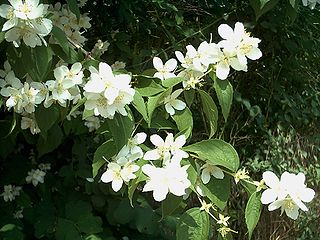
Philadelphus coronarius is a species of flowering plant in the family Hydrangeaceae, native to Southern Europe.

Duranta erecta is a species of flowering shrub in the verbena family Verbenaceae, native from Mexico to South America and the Caribbean. It is widely cultivated as an ornamental plant in tropical and subtropical gardens throughout the world, and has become naturalized in many places. Common names include golden dewdrop, pigeon berry, and skyflower.

Salvia microphylla, the baby sage, Graham's sage, or blackcurrant sage, is an evergreen shrub found in the wild in southeastern Arizona and the mountains of eastern, western, and southern Mexico. It is a very complex species which easily hybridizes, resulting in numerous hybrids and cultivars brought into horticulture since the 1990s. The specific epithet microphylla, from the Greek, means "small leaved". In Mexico it is called mirto de montes, or "myrtle of the mountains".

Cotoneaster salicifolius, the willow-leaved cotoneaster, is a drought-tolerant, evergreen to semi-evergreen, low-lying, small to medium-sized shrub with an arched branching habit. Specimens growing in the wild, however, are generally larger, averaging five meters in height. Although native to the mountains, mixed forests, and open places in western China, it is commonly cultivated in temperate climates worldwide. Cultivars have been bred in a variety of forms, as ornamental groundcovers or shrubs.

Hydrangea serrata is a species of flowering plant in the family Hydrangeaceae, native to mountainous regions of Korea and Japan. Common names include mountain hydrangea and tea of heaven. Growing to 1.2 m (4 ft) tall and broad, it is a deciduous shrub with oval leaves and panicles of blue and pink flowers in summer and autumn (fall). It is widely cultivated as an attractive ornamental shrub throughout the world in areas with suitable climate and soil.

Hydrangea paniculata, or panicled hydrangea, is a species of flowering plant in the family Hydrangeaceae native to southern and eastern China, Korea, Japan and Russia (Sakhalin). It was first formally described by Philipp Franz von Siebold in 1829.
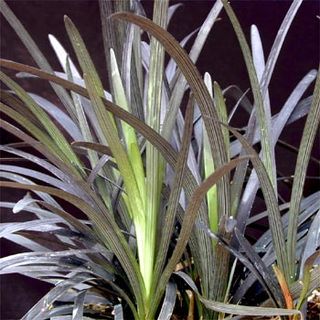
Ophiopogon planiscapus is a species of flowering plant in the family Asparagaceae. It is a small evergreen perennial growing to 20 cm (8 in) tall by 30 cm (12 in)wide. It grows from short rhizomes, and bears tufts of grasslike leaves, from which purple or white flowers emerge in racemes held on short stems above the leaves. It is native to Japan, where it grows on open and forested slopes.
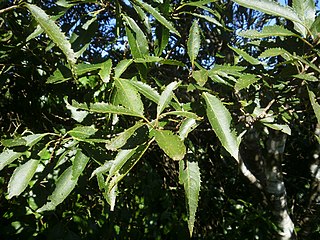
Hoheria sexstylosa, the long-leaved lacebark or ribbonwood, is a species of flowering plant in the family Malvaceae, endemic to New Zealand. It is an evergreen tree or shrub growing to 8 m (26 ft) tall by 6 m (20 ft) broad with glossy green leaves, and white flowers in summer and autumn. The Latin specific epithet sexstylosa means "six styles".

Syringa pubescens is a species of flowering plant in the lilac genus of the family Oleaceae, native to Korea and China.

Sarcococca ruscifolia (野扇花) is a species of flowering plant in the box family Buxaceae, native to China, where it inhabits forested mountain slopes. Growing to 1 m (3.3 ft) tall and broad, it is a compact evergreen shrub with shiny oval leaves. Fragrant white flowers in winter are followed by red berries.

